Catalpa and the nuances of growing a tree

According to current statistics, the number of gardeners interested in the features of the catalpa tree and the nuances of its cultivation is growing steadily. This North American guest has taken root well in the southern regions of the Russian Federation, including Crimea. In addition, the plant also feels comfortable in the south of the middle lane. Moreover, it can be found even in Western Siberia. It is worth noting that these trees become a real decoration of any site, regardless of the season.

general description
For the first time this representative of the Bignoniev family was described by Karl Linnaeus, and this happened back in 1735. Despite the fact that catalpa began to spread almost throughout the world from North America, China is its homeland. Today you can find both tree and shrub forms. This culture is also known as the "tree of happiness", which it owes to the Indians, who believed that the plant was able to bring good luck and family well-being.
In some countries, the catalpa is called the "macaroni tree" because of the long pods that adorn the crown after flowering. There is also another unofficial name. Due to the size and shape of the leaf plates, the plant was nicknamed "elephant ears".

The main distinguishing features of the catalpa will be as follows.
- Relatively thin trunks, reaching no more than 20 cm in diameter.
- Durable wood.
- Candle-shaped inflorescences, somewhat similar to chestnuts, with large flowers resembling orchid-shaped bells.
- Large leaf plates, the size of which reaches 15x20 cm, with long petioles. Outwardly, they resemble huge lilac leaves.
- The fruits are elongated (often up to 0.5 m) pod-pods. After full ripening, they split into two parts, releasing a large number of small and winged seeds.


Views
It should be noted right away that not all varieties of catalpa known today are grown as ornamental. So, in the middle lane, the following types are among the most popular.
- Lovely (splendid) catalpa. Deservedly is one of the tallest members of the family, capable of growing up to a record 30 m. The slender trunk of the tree is decorated with a pyramidal crown and pale white buds during the flowering period. It can withstand frosts down to -28 degrees.

- Ordinary (bignoniform or lilac-leaved). The crown, which has a rounded shape, can grow up to 20 m.The main feature is the flowers, the length and width of which are up to 30 and 20 cm.
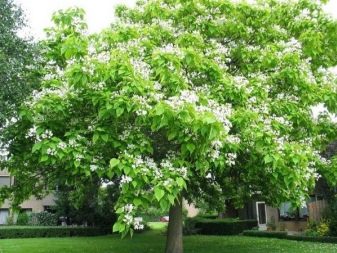

- Ovoid (she is Ovata's catalpa). This is a low-growing catalpa (in its natural environment it grows up to 10 m, and in areas up to 4 m in height). The ball-shaped crown is decorated with crème brulee-colored buds with a violet hue, which have a characteristic pleasant aroma.


- Fargeza... This medium-sized variety is quite demanding in terms of temperature. It has pink or pink-purple flowers that bloom much earlier than the vast majority of relatives.
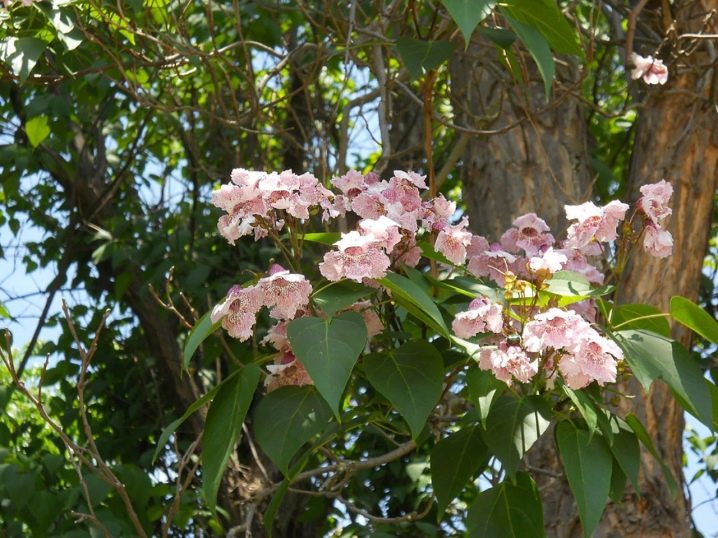
- Hybrid... The winter-hardy result of crossing the common catalpa and ovoid. The maximum tree height is 16 m, and the crown is hemispherical.
In addition to all those described, it is also worth paying attention to such an interspecific hybrid as the reddening catalpa.In height, such trees with two types of leaf plates stretch up to 10 m.

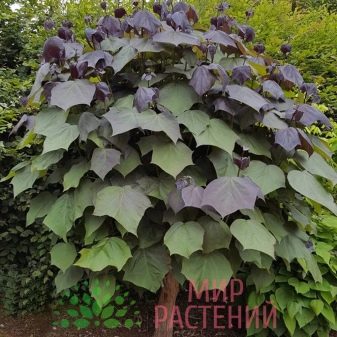
Landing
Initially, it is important to note that when growing catalpa both from seeds and cuttings, it takes root well and grows very quickly in the open field. It is worth considering that the algorithm of actions in both cases will be almost the same. Planting a young tree in a permanent place is best done in the spring and before the beginning of the active growing season. On the other hand, autumn planting is also allowed, but it should be done after all the leaves have fallen off.
As part of the preparatory activities, it is important to focus on the correct choice of a site for planting catalpa. This should be a fully illuminated and in parallel securely protected from the wind place. An equally important point is the composition of the soil. The best option would be a well-drained soil with a neutral pH and deep groundwater, which is located at a depth of at least 2 meters.


The landing procedure includes the following steps:
- the site is dug up and a mixture of humus and charcoal is introduced into the soil;
- holes are prepared with a depth and width of about 1 and 0.5 m, respectively;
- at the bottom of the planting pit, a drainage layer is arranged using broken brick or crushed stone;
- the hole is half filled with soil mixture, which includes deciduous soil, peat, sand and humus, ash and phosphorus fertilizers;
- 2-3 hours before planting, the underground part of the seedling is soaked to saturate it with moisture;
- the tree is transferred to the hole and filled with the remaining soil mixture, which is compacted and trampled a little in the near-trunk zone;
- water the seedling abundantly and mulch the soil with peat (this organic layer on the surface will prevent moisture evaporation and, in parallel, provide an additional source of nutrients).


For planting, you should choose seedlings aged 1-2 years with a fully developed root system and strong healthy shoots... If several seedlings are planted in a group, then gaps of about 4 meters should be made between them.
It is important to remember here that catalpa tends to grow actively. And we are talking about both the crown of trees and their underground part.

Care
To grow catalpa in the garden, you don't have to put in too much effort. By the way, this is also true for growing trees at home. However, this does not mean that elementary rules and standard agricultural practices can be ignored.
It is important to provide the plant with moisture and nutrients in a timely manner. No less significant in this case is also the formation of the crown of trees (for example, a ball on a trunk), taking into account their decorative properties.
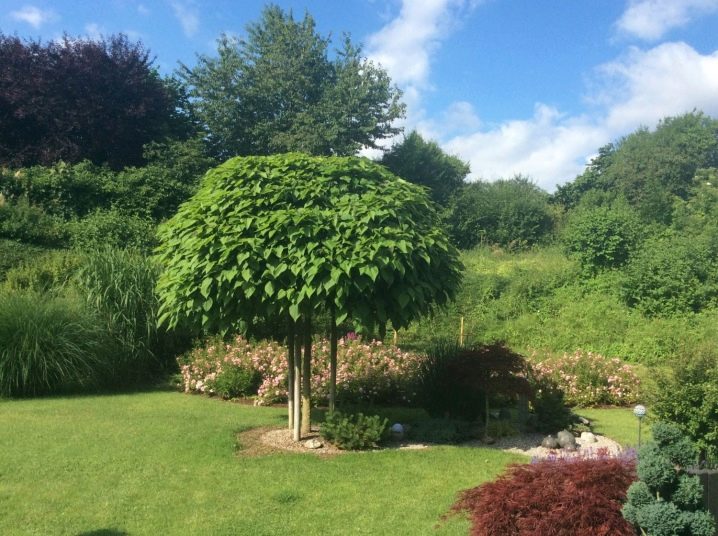
Watering and feeding
The cultivation of this exotic garden dweller provides for regular (at least 1 time per week) irrigation. In this case, the water consumption is up to 2 buckets for each adult. However, it is worth considering certain nuances regarding the frequency of the procedures. And here the weather conditions in a specific period of time will play a key role. With sufficient precipitation, watering can be reduced to 3 times a month, while in the heat it is often necessary to moisten the soil 2 times a week.
As the long-term practice of growing catalpa in gardens and at home shows, this plant responds with a certain enthusiasm to the use of fertilizers... Experienced gardeners strongly recommend scheduling soil fertilization. And it is important at the same time that each session is ultimately clearly fixed, and there are no long breaks between them.
It should also be borne in mind that in the fall, catalpa requires feeding with an increased concentration of potassium.
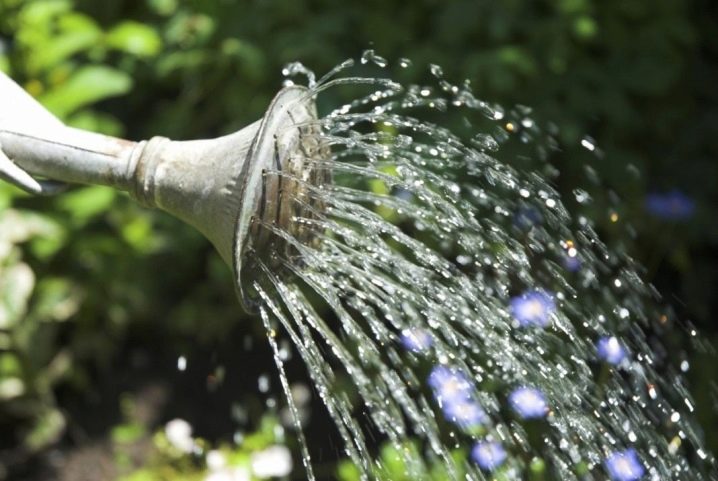
Pruning
Such an agrotechnical technique is focused on giving the described plants maximum aesthetics.... Spring is considered the most favorable time for pruning.The key point here is that the buds on the trees have not yet fully formed. And the procedure itself provides for the removal of frostbitten, dried, diseased and damaged branches.
Among other things, experienced gardeners and experts recommend getting rid of improperly growing shoots. Otherwise, the appearance of the catalpa may be significantly affected.
By the way, the crown should be formed in the spring.

Loosening and mulching
It is important that the soil is constantly and fully saturated with oxygen, which is so necessary for the development of the root system and the tree itself. That is why, after each irrigation, it is required to loosen the soil in the near-stem zone. The depth of treatment should be small, because there is a risk of damaging the roots. In parallel with weeding and loosening, experienced gardeners recommend mulching the soil with sawdust. This approach will slow down the evaporation of moisture and control the growth of weeds.
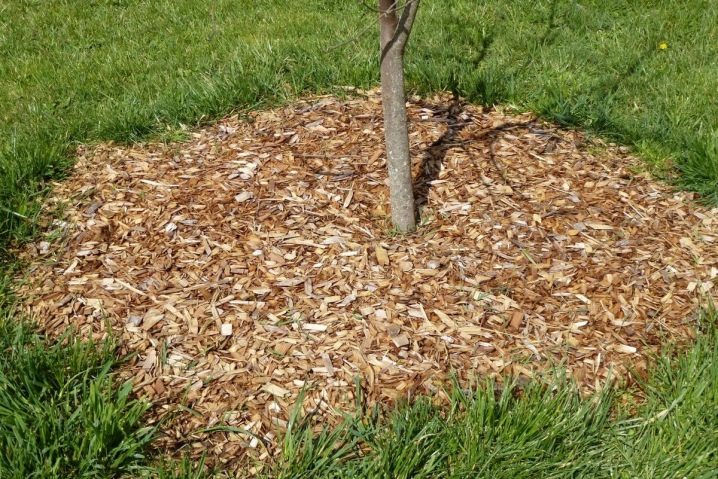
Wintering
The described culture is characterized by sufficient frost resistance provided that the seedlings are grown under appropriate conditions. However, young animals that have emerged from nurseries are not fully insured against freezing. It is for this reason that in the first few years of a tree's life, it will be necessary to provide it with a reliable shelter for the winter. Before freezing, it is necessary to have time to wrap up the plants with any non-woven material, simultaneously mulching the trunk circles with a 10-centimeter layer of peat or humus. The tops caught in severe frosts are simply cut off in the spring, which does not in any way affect the development and flowering.
Adults do not need such events on the eve of the winter cold. Here, a sufficient measure will be to create a dense layer of organic matter around, which will perform the functions of an effective insulation.
By the way, in order to protect trees from cold winter winds, it is recommended to place them under the cover of various buildings and structures, as well as conifers that will be located from the north.

Reproduction
It is recommended to sow seeds for seedlings in the ground towards the end of February and at the beginning of the first spring month. Previously, the material must be soaked for 12 hours. If autumn sowing is carried out, then this procedure is not required. The process of sowing and germinating catalpa seeds is as follows:
- prepare containers of suitable size and depth;
- fill containers with substrate and make shallow grooves;
- distribute catalpa seeds in the grooves;
- sprinkle the seed with soil mixture;
- conduct moderate watering of crops;
- containers are covered with glass or transparent film to create greenhouse conditions;
- containers with seeds are placed in rooms with a temperature of 20-22 degrees;
- the plantings are aired daily, taking off cover for 10 minutes.
It is important to provide the germinating seeds with adequate lighting.... It should be remembered, however, that direct sunlight can be harmful. Another key point is regular soil moisture. And, summing up, it is important to note that landing in open ground is carried out no earlier than mid-May.

Catalpa, in addition to using the seed method, can also be propagated by cuttings. Here it should be clarified that the material itself in the form of cuttings is harvested in August. It is important that their length is from 8 cm and fully formed living buds are always present. Such cuttings are placed in a substrate (peat and sand) without any preliminary preparation. In this case, you will need to equip mini-greenhouses with cut-off plastic bottles.
They take care of rooting future seedlings in the same way as seedlings. The list of compulsory agrotechnical measures includes watering, daily airing, loosening of the soil mixture. Landing in open ground is also carried out towards the end of May.

Diseases and pests
Catalpa is more of an ornamental plant, but it boasts good immunity. It allows her to successfully resist many common diseases from which most garden dwellers suffer. However, it is worth considering that resistance to various infections directly depends on how competently tree care is carried out. Often, when violating the rules of agricultural technology, gardeners are faced with situations when, for example, the leaf plates of a catalpa curl, turn black and die off.
By the way, in some cases, ailments or the consequences of a pest attack may not respond to treatment, then the only way out is to destroy the plant. One of these very dangerous defeats can be attributed to the attack of the Spanish fly.
At the slightest suspicion of the presence of this parasite, appropriate treatment should be carried out immediately. Systemic insecticides will be most effective here.

Another pest that is potentially dangerous for catalpa is horntail. It lays its larvae in the bark, which suffers greatly as a result. This predictably leads to rapid wilting. Unfortunately, most often the activity of horntail larvae leads to the death of the tree. At the same time, regular treatment with insecticides for preventive purposes will allow the plant to be protected.
Along with harmful insects, the described representative of the exotic flora can be affected by such a dangerous disease as verticillary wilting... Its symptoms are yellowing and subsequent fall of foliage. It is important to remember that a tree can be cured only at the initial stage, and at the same time, "Fundazol" and other means of similar action are used. If the disease has developed, then the plant will have to be removed. Do not forget about the risk of powdery mildew damage.
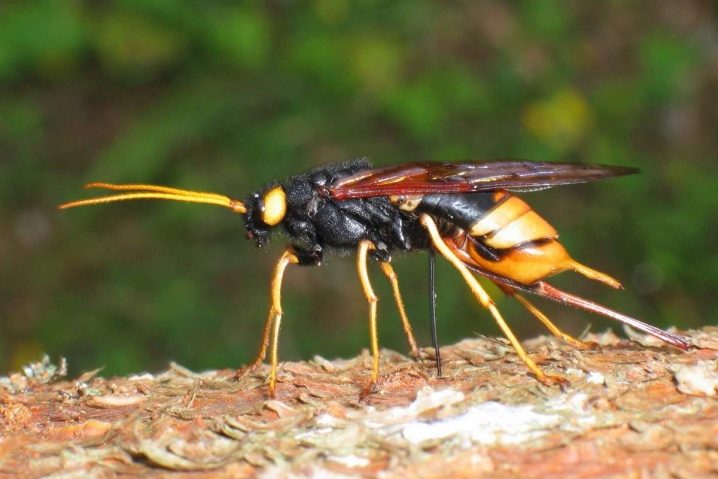
Application in landscape design
Catalpa is the most attractive plant at any time of the year. So, in spring, trees are able to amaze with their beautiful and huge, like elephant ears, leaf plates. In summer, the crowns are decorated with candles of inflorescences, all this resembles a real birthday cake.
It is noteworthy that the green foliage is preserved until the first frost, that is, the plants do not change into autumn outfits, like most of their deciduous counterparts.
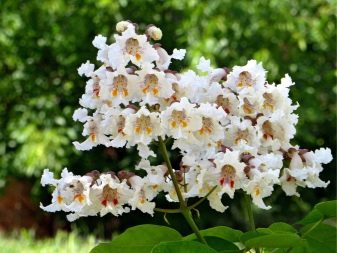

And even in winter, adults are able to decorate their garden and backyard plots with their appearance. Peculiar earrings in the form of dried pods are covered with ice during frost and look like little popsicle. As a result, the catalpa can become a unique element of the landscape:
- parka;
- alleys;
- prospectus;
- garden, suburban and personal plot.
The described trees look equally impressive both individually and as components of various landscape compositions. For example, they successfully decorate paths in gardens and parks, turning them into alleys that are unique from an aesthetic point of view.

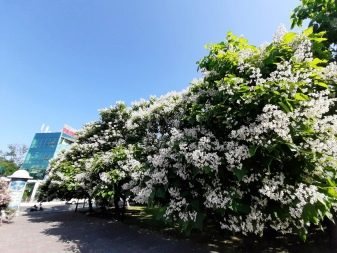





























































The comment was sent successfully.